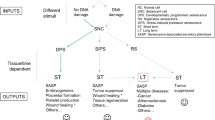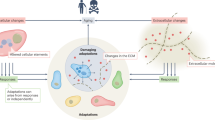Abstract
Today, gerontologists usually employ certain molecular or cellular biomarkers of aging to evaluate the effects of various interventions in this process, since this approach is much more time-efficient than the construction of survival curves. However, arguments for the expediency of using such biomarkers are often based on the results of studies on what is called cell/cellular senescence. Unfortunately, the usage of this term has recently evolved so that it has largely lost its initial meaning, which is that normal cultured cells are subject to replicative senescence (according to the Hayflick phenomenon) and undergo changes similar to those in the cells of an aging organism. Most of recent studies in this field deal with the induction of relevant changes in cultured (usually transformed) cells by various DNA-damaging factors. Such an approach is important for defining the strategy of cancer control but, yet again, leads away from the study of actual mechanisms of organismal aging. Moreover, there are grounds to consider that biomarkers of aging identified in these studies (in particular, senescence-associated beta-galactosidase activity, the most popular among them) are basically linked to cell proliferative status. At the organismal level, this status is generally determined by the program of development and differentiation of tissues and organs, which in a definitive state are composed of postmitotic or very slowly propagating cells. Therefore, it appears that canceling the aging program will not cause any significant changes in the age-dependent dynamics of the above biomarkers. This conclusion brings us back to the necessity of constructing the survival curves for test groups of animals or humans as the only reliable (though expensive and time-inefficient) approach to evaluating the efficiency of means to modify the aging process.
Similar content being viewed by others
References
Olovnikov, A.M., The principle of marginotomy in the template synthesis of polynucleotides, Dokl. Akad. Nauk SSSR, 1971, vol. 201, no. 6, pp. 1496–1499.
Khokhlov, A.N., Proliferatsiya i starenie (Cell Proliferation and Aging), Itogi Nauki i Tekhniki VINITI AN SSSR. Ser. Obshchie Problemy Fiziko-Khimicheskoi Biologii (Advances in Science and Technology, VINITI Akad. Sci. USSR, Ser. General Problems of Physicochemical Biology), Moscow: VINITI, 1988, vol. 9.
Khokhlov, A.N., Results and perspectives of cytogerontologic studies in modern time, Tsitologiia, 2002, vol. 44, no. 12, pp. 1143–1148.
Khokhlov, A.N., Gerontological studies on cell cultures: from organism to cell and back, Probl. Staren. Dolgolet., 2008, vol. 17, no. 4, pp. 451–456.
Khokhlov, A.N., Testing geroprotectors in cell culture experiments: pros and cons, Probl. Staren. Dolgolet., 2009, vol. 18, no. 1, pp. 32–36.
Akimov, S.S. and Khokhlov, A.N., Study of “stationary phase aging” of cultured cells under various types of proliferation restriction, Ann. N.Y. Acad. Sci., 1998, vol. 854, p. 520.
Alinkina, E.S., Vorobyova, A.K., Misharina, T.A., et al., Cytogerontological studies of biological activity of oregano essential oil, Moscow Univ. Biol. Sci. Bull., 2012, vol. 67, no. 2, pp. 52–57.
Campisi, J., Aging, cellular senescence, and cancer, Annu. Rev. Physiol., 2013, vol. 75, pp. 685–705.
Carrel, A., Artificial activation of the growth in vitro of connective tissue, J. Exp. Med., 1912, vol. 17, no. 1, pp. 14–19.
Carrel, A., Contributions to the study of the mechanism of the growth of connective tissue, J. Exp. Med., 1913, vol. 18, no. 3, pp. 287–289.
Choi, J., Shendrik, I., Peacocke, M., et al., Expression of senescence-associated beta-galactosidase in enlarged prostates from men with benign prostatic hyperplasia, Urology, 2000, vol. 56, no. 1, pp. 160–166.
Cristofalo, V.J., SA beta Gal staining: biomarker or delusion, Exp. Gerontol., 2005, vol. 40, no. 10, pp. 836–838.
Dimri, G.P., Lee, X., Basile, G., et al., A biomarker that identifies senescent human cells in culture and in aging skin in vivo, Proc. Natl. Acad. Sci. USA, 1995, vol. 92, no. 20, pp. 9363–9367.
Giaimo, S. and D’Adda di Fagagna, F., Is cellular senescence an example of antagonistic pleiotropy?, Aging Cell, 2012, vol. 11, no. 3, pp. 378–383.
Harman, D., About origin and evolution of the free radical theory of aging: a brief personal history, 1954–2009, Biogerontology, 2009, vol. 10, no. 6, p. 783.
Hayflick, L., The limited in vitro lifetime of human diploid cell strains, Exp. Cell Res., 1965, vol. 37, no. 3, pp. 614–636.
Hayflick, L., Progress in cytogerontology, Mech. Aging Dev., 1979, vol. 9, nos. 5–6, pp. 393–408.
Hayflick, L., How and Why We Age, New York: Ballantine Books, 1996.
Hayflick, L. and Moorhead, P.S., The serial cultivation of human diploid cell strains, Exp. Cell Res., 1961, vol. 25, no. 3, pp. 585–621.
Jeyapalan, J.C. and Sedivy, J.M., Cellular senescence and organism aging, Mech. Aging Dev., 2008, vol. 129, nos. 7–8, pp. 467–474.
Kang, H.T., Lee, C.J., Seo, E.J., et al., Transition to an irreversible state of senescence in HeLa cells arrested by repression of HPV E6 and E7 genes, Mech. Aging Dev., 2004, vol. 125, no. 1, pp. 31–40.
Khokhlov, A.N., Stationary cell cultures as a tool for gerontological studies, Ann. N.Y. Acad. Sci., 1992, vol. 663, pp. 475–476.
Khokhlov, A.N., The cell kinetics model for determination of organism biological age and for geroprotectors or geropromoters studies, in Biomarkers of Aging: Expression and Regulation. Proceeding, Licastro, F. and Caldarera, C.M., Eds., Bologna: CLUEB, 1992, pp. 209–216.
Khokhlov, A.N., Cell proliferation restriction: is it the primary cause of aging?, Ann. N.Y. Acad. Sci., 1998, vol. 854, p. 519.
Khokhlov, A.N., Cytogerontology at the beginning of the third millennium: from “correlative” to “gist” models, Russ. J. Dev. Biol., 2003, vol. 34, no. 5, pp. 321–326.
Khokhlov, A.N., From Carrel to Hayflick and back, or what we got from the 100-year cytogerontological studies, Biophysics, 2010, vol. 55, no. 5, pp. 859–864.
Khokhlov, A.N., Does aging need an own program or the existing development program is more than enough?, Russ. J. Gen. Chem., 2010, vol. 80, no. 7, pp. 1507–1513.
Khokhlov, A.N., Does aging need its own program, or is the program of development quite sufficient for it? Stationary cell cultures as a tool to search for anti-aging factors, Curr. Aging Sci., 2013, vol. 6, no. 1, pp. 14–20.
Khokhlov, A.N., Wei, L., Li, Y., and He, J., Teaching cytogerontology in Russia and China, Adv. Gerontol., 2012, vol. 25, no. 3, pp. 513–516.
Kirkwood, T.B. and Cremer, T., Cytogerontology since 1881: a reappraisal of August Weismann and a review of modern progress, Hum. Genet., 1982, vol. 60, no. 2, pp. 101–121.
Krishna, D.R., Sperker, B., Fritz, P., and Klotz, U., Does pH 6 beta-galactosidase activity indicate cell senescence?, Mech. Aging Dev., 1999, vol. 109, no. 2, pp. 113–123.
Kuilman, T., Michaloglou, C., Mooi, W.J., and Peeper, D.S., The essence of senescence, Genes Dev., 2010, vol. 24, no. 22, pp. 2463–2479.
Lawless, C., Wang, C., Jurk, D., et al., Quantitative assessment of markers for cell senescence, Exp. Gerontol., 2010, vol. 45, no. 10, pp. 772–778.
Rattan, S.I.S., “Just a fellow who did his job…” an interview with Leonard Hayflick, Biogerontology, 2000, vol. 1, no. 1, pp. 79–87.
Severino, J., Allen, R.G., Balin, S., et al., Is beta-galactosidase staining a marker of senescence in vitro and in vivo?, Exp. Cell Res., 2000, vol. 257, no. 1, pp. 162–171.
Sikora, E., Arendt, T., Bennett, M., and Narita, M., Impact of cellular senescence signature on ageing research, Ageing Res. Rev., 2011, vol. 10, no. 1, pp. 146–152.
Swim, H.E. and Parker, R.F., Culture characteristics of human fibroblasts propagated serially, Amer. J. Hyg., 1957, vol. 66, no. 2, pp. 235–243.
Untergasser, G., Gander, R., Rumpold, H., et al., TGF-beta cytokines increase senescence-associated beta-galactosidase activity in human prostate basal cells by supporting differentiation processes, but not cellular senescence, Exp. Gerontol., 2003, vol. 38, no. 10, pp. 1179–1188.
Vilenchik, M.M., Khokhlov, A.N., and Grinberg, K.N., Study of spontaneous DNA lesions and DNA repair in human diploid fibroblasts aged in vitro and in vivo, Studia Biophys., 1981, vol. 85, no. 1, pp. 53–54.
Vladimirova, I.V., Shilovsky, G.A., Khokhlov, A.N., and Shram, S.I., “Age-related” changes of the poly(ADP-ribosyl) action system in cultured Chinese hamster cells, in Visualizing of senescent cells in vitro and in vivo. Programme and abstracts, Warsaw, Poland, December 15–16, 2012, Warsaw, 2012, pp. 108–109.
Wei, L., Li, Y., He, J., and Khokhlov, A.N., Teaching the cell biology of aging at the Harbin Institute of Technology and Moscow State University, Moscow Univ. Biol. Sci. Bull., 2012, vol. 67, no. 1, pp. 13–16.
Weismann, A., Das Keimplasma. Eine Theorie der Vererbung, Jena: G. Fisher Ferlag, 1892.
Weismann, A., Die Kontinuitat des Keimplasmas als Grundlage einer Theorie der Vererbung, Jena: G. Fisher Ferlag, 1885.
Yegorov, Y.E., Akimov, S.S., Hass, R., et al., Endogenous beta-galactosidase activity in continuously nonproliferating cells, Exp. Cell Res., 1998, vol. 243, no. 1, pp. 207–211.
Author information
Authors and Affiliations
Corresponding author
Additional information
Original Russian Text © A.N. Khokhlov, 2013, published in Uspekhi Gerontologii, 2013, Vol. 26, No. 3, pp. 419–424.
Rights and permissions
About this article
Cite this article
Khokhlov, A.N. What will happen to molecular and cellular biomarkers of aging in case its program is canceled (provided such a program does exist)?. Adv Gerontol 4, 150–154 (2014). https://doi.org/10.1134/S2079057014020088
Published:
Issue Date:
DOI: https://doi.org/10.1134/S2079057014020088




